How to optimize your Google My Business listing
The 4-step process to get more customers (and revenue).
Update: Google My Business is now "Google Business Profile". The name change doesn't impact the process on this page.
Google My Business can be a high-octane revenue engine.
Most companies miss the boat on this - which means they're leaving a lot of money on the table.
You need to optimize your listing to get the most customers and revenue.
(Taking a "set and forget" approach isn't good enough.)
This article will show you how.
The framework I'm going to show you is the result of:
- 381,000 search results pages scraped.
- Over 1,000,000 Google My Business listings analyzed.
- More than 600 listings personally optimized.
It's not based on theory.
It's based on what's working - right now.
By introducing you to this framework, I'm hoping you'll get results like these:
- A law firm increased phone calls by 114%
- A flower shop doubled foot traffic
- An e-commerce store added six figures in extra revenue (by doing this in multiple cities)
Before we jump in, I'd like to address one myth about Google My Business...
Myth:
"If your website doesn't rank well, your Google My Business listing won't either."
At worst, it's a lazy way for some marketers to take advantage of their less-than-knowledgeable clients.
At best, these marketers are mistaking correlation for causation.
Here's the truth:
Based on two data sets - one by STAT (a search analytics platform) and another by yours truly - there is almost zero correlation between your website's performance in organic search and your Google My Business listing.
It's important to note what I mean by *almost* here.
There was a weak correlation at best, with just 17% of top ranking Google My Business listings having an associated website ranking on the first page.
Now that we've gotten that out of the way, let's jump in.
Introducing:
The Optimization Pyramid
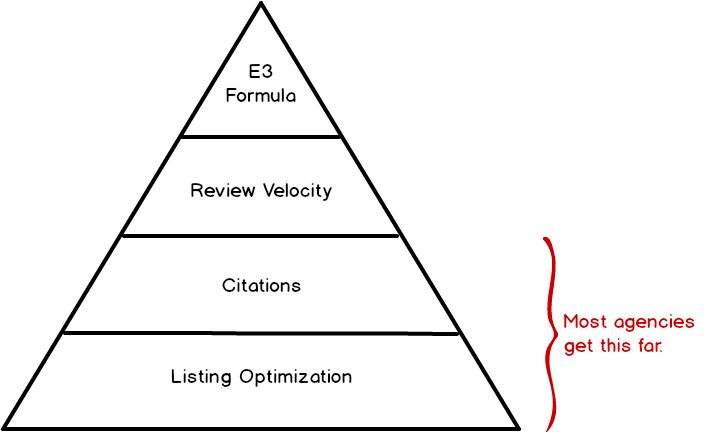
There are four steps to building a Google My Business listing that outperforms your toughest competitors.
It all comes together in a framework I call the Optimization Pyramid.
Level I: Listing Optimization
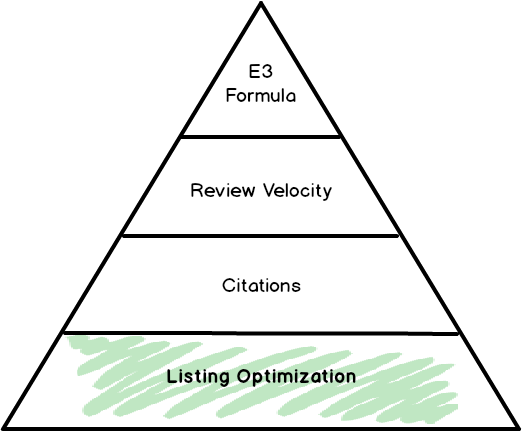
This is the foundational stuff that should be done when you create your listing - and then revisited every 3 months to ensure it is up to date.
This includes:
- Basic business info
- Primary and secondary categories
- Photos (geo-tag these for best results)
- Website (should be linking to a "local landing page" here)
- Add-on features (depending on your business category)
Update: Google has released a few features to help businesses during the pandemic (e.g. secondary hours and online attributes). Make you use these - they help elevate your visibility in some cases.
If you're not sure if you've verified your listing, you can usually tell by logging into your Google My Business account.
If you have not verified, you'll see some sort of message like this:

Level II: Citation Building
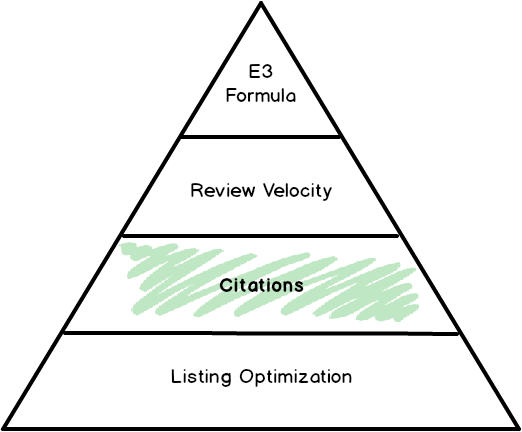
Citations are instances of your company information on other websites.
These are also known as NAP signals (name/address/phone).
These include your:
- Business Name
- Address
- Phone Number
- Website
Think of citations as votes for your Google My Business listing.
Similar to how links can push up rankings for your site, citations have a similar effect for Google My Business.
Citations are one of the key drivers of your listing's performance - so don't gloss over them.
Two things matter most for citations:
Consistency: Attention to detail is very important here. Your citations should be *exactly* the same across all websites.
For example, if you put your suite number on the Address 2 line - then it should be like that everywhere.
Another example: If you've formatted your number as (XXX) XXX-XXXX then you should keep this formatting for your citations.
Total number of citations: Google uses citations as votes of confidence that your business is legitimate - and that it's actually located where you say it is.
The more correct citations on other websites, the more confidence they'll have in your business.
Level III: Review Velocity
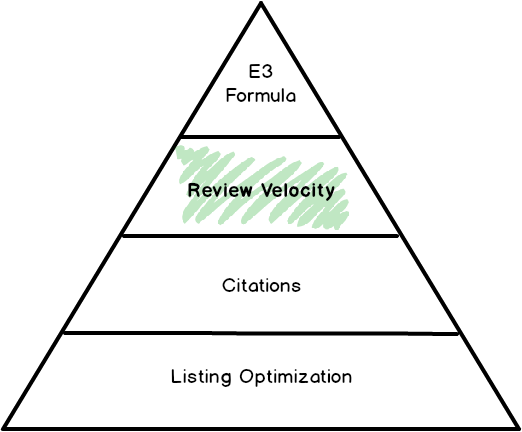
Reviews on trusted platforms like Google are the single most persuasive asset for getting insane amounts of customers online.
This is why Google My Business is so powerful.
Not only are these reviews front and center when people are searching for your products and services - they're on a trusted platform - one that people will trust much more than if you just said how great you are on your own website.
Reviews are very important for your listing's visibility in Google Search and Google Maps.
But not in the way you may think.
While the quality of your reviews are important for obvious reasons (people want to do business with companies that have raving fans) - it's actually the velocity of your reviews which really matters.
Review Velocity: The speed at which you are getting new reviews on your listing.
There are ways to ethically manipulate your review velocity - and it leads to big gains for your business in terms of customers and revenue.
This is something I cover in detail in the Execution Plan on the next page.
I find it works especially well for companies in not so sexy industries where getting reviews is especially difficult.
Level IV: The E3 Formula
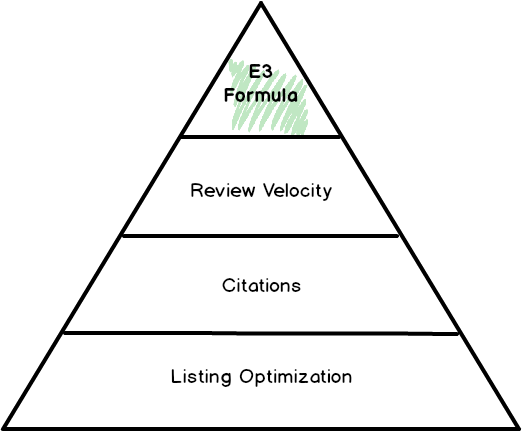
This is what separates your listing from the rest of your competitors on two levels:
- You'll get more visibility on Google Search and Maps
- Your listing will become way more persuasive to people viewing it
It was a key finding in my latest research.
It's what I call the E3 Formula.
And it's all about engagement.
Given the research and tests, engagement falls into three distinct categories:
Posts: Google My Business posts are a vastly under-utilized feature that Google rolled out.
Here's why you should be using them:
1. When used correctly, they help improve your listing's visibility for keywords outside of your primary and secondary business categories.
2. If your posts receive more clicks and views, it shows Google that people are favoring your business over others.
3. You can use these to feature promotions and updates that help to further capture the attention of your prospective customers.
User Engagement: If your listing gets tons of people "liking" reviews, asking questions, and posting photos - while your competitors get almost none of these - what do you think this tells Google?
It tells them that your listing is more relevant than your competitors, and you will be rewarded for it.
Owner Engagement: Engagement can't just be a one way street, where your company forgets all about its listing.
This is the last piece of the E3 Formula, and here's what it entails:
- Prompt replies to messages (did I mentioned Google My Business has a slick messaging feature?)
- Responses to both positive and negative reviews
- Answers to questions
- Adding new images or videos consistently
What happens when your company follows the Optimization Pyramid?
In short: Your company grows.
It gets you better visibility in Google Search and Maps.
It grows your number of first time customers - who turn into fans of your business.
Your customers turn into more social proof for your listing.
This further accelerates your visibility - which gets you even more customers.
And most importantly - your revenue grows.
It's a feedback loop that looks something like this:

It has the power to get results like this:
- A law firm increased phone calls by 114%
- A flower shop doubled foot traffic
- An e-commerce store added six figures in extra revenue (by doing this in multiple cities)
Those aren't random, flash-in-the-pan results.
The phone calls, visits, and most importantly - revenue - comes in for these businesses months and years down the road.
Google My Business will grow your company's bottom line, if you let it.
Are you ready to grow?
What to do next
- Learn about the Execution Plan - and get results in half the time.
- Execute on what you've learned. This knowledge is useless unless acted on.